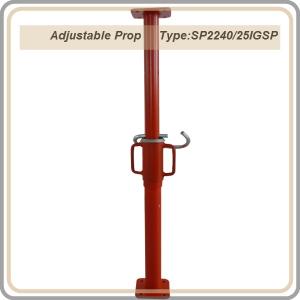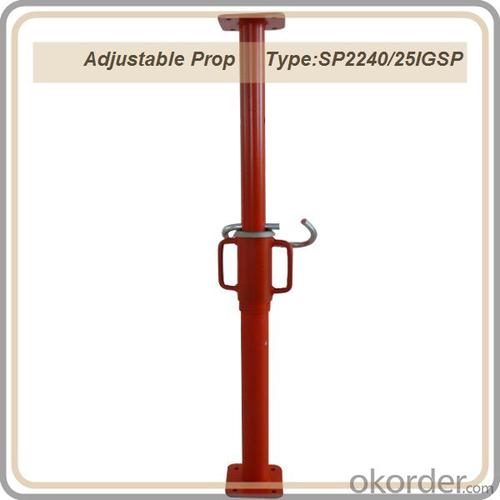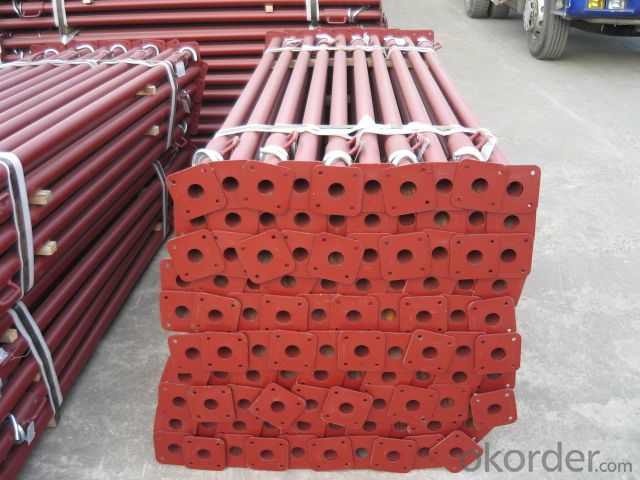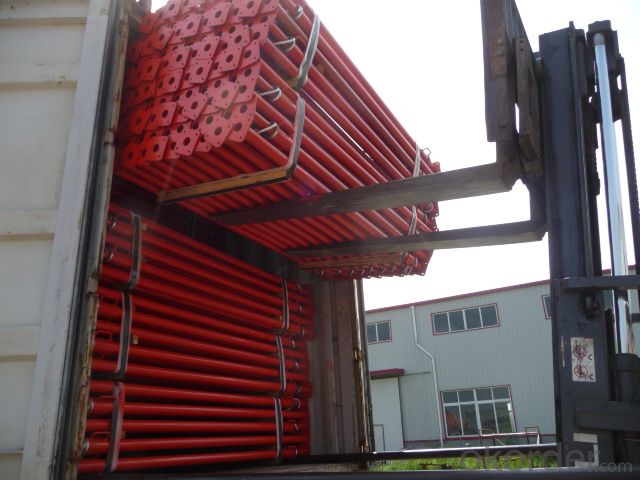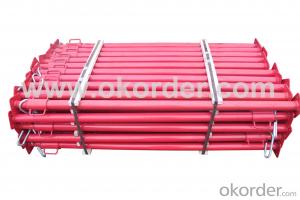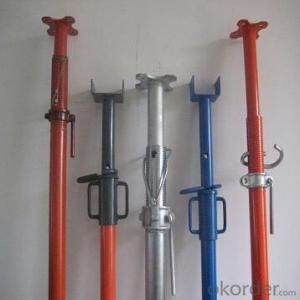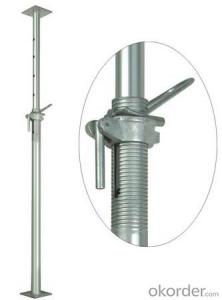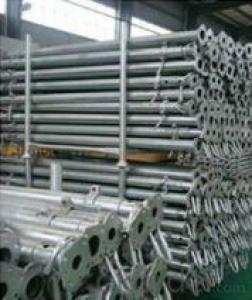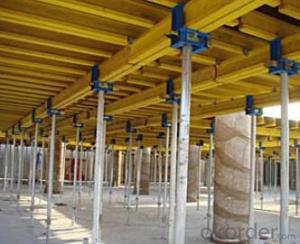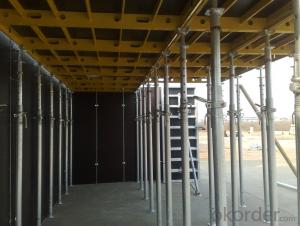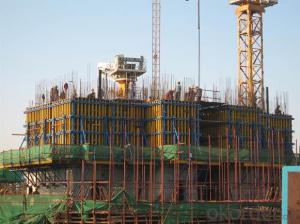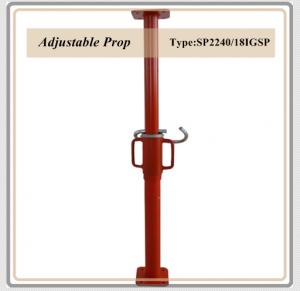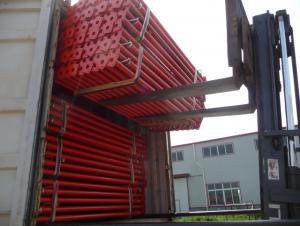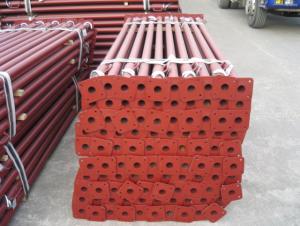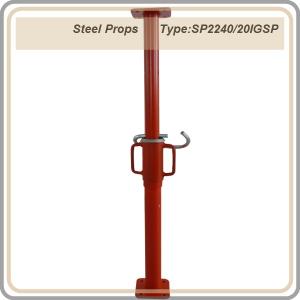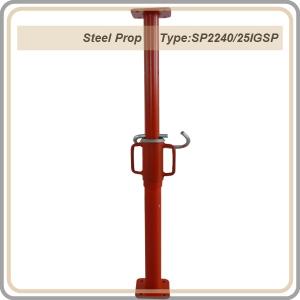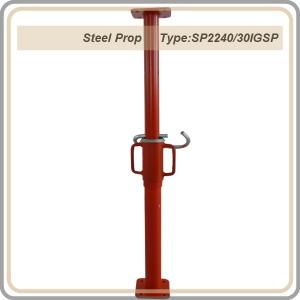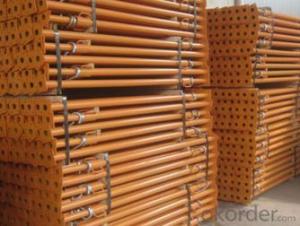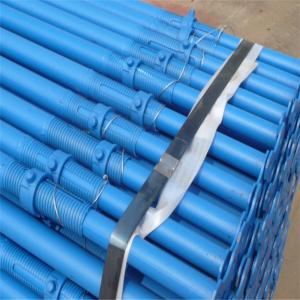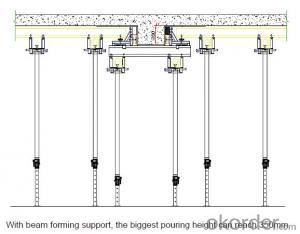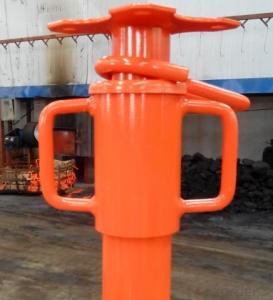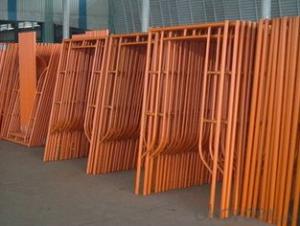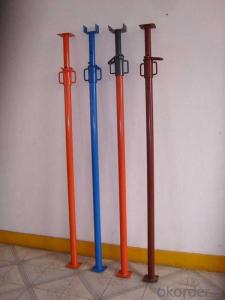Export Adjustable Props /painted surface steel prop/ red color prop 2.2-4M
- Loading Port:
- China Main Port
- Payment Terms:
- TT or LC
- Min Order Qty:
- 1680 Piece/Pieces pc
- Supply Capability:
- 10000 pc/month
OKorder Service Pledge
OKorder Financial Service
You Might Also Like
1. Length 2200-4000mm
2. Outer tube diameter 56mm
3. Inner tube diameter 48mm
4. Tube material : Q235
5. Tube thickness : 2.5mm
6. weight : 12.9kgs
7. square plate : 120*120*4mm
8. Italian type nut
9. G-pin 12
10. Painted surface
11. Color : as customer 's request . red / blue / green / orange/ brown
Packaging & Delivery
| Packaging Details: | packaging :50pcs / bale container : 1680pcs / 20ft |
|---|---|
| Delivery Detail: | 20-30days after receive deposit |
Specifications
Adjustable props / construction prop
Height 2.2-4M
Italy type painted props
Adjustable props
Shoring props
Construction scaffold steel prop
Scaffold props
Telescopic steel props
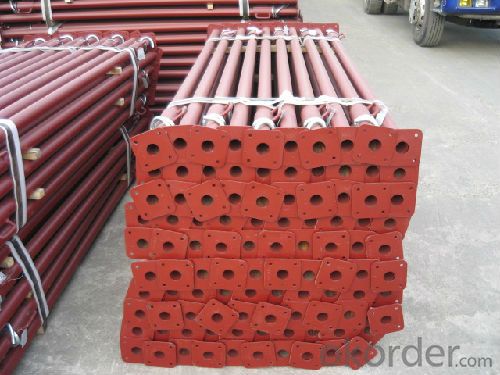
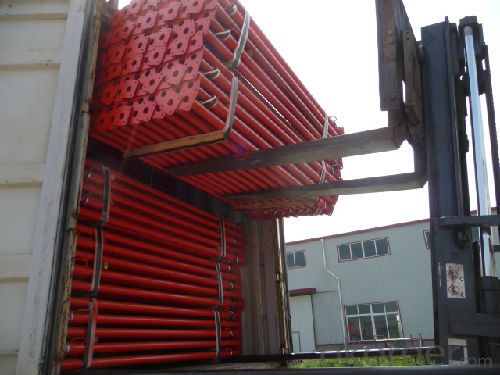

Product introduce
Steel Prop is a labour and time saving device to support shuttering and centering.
It is made outer tube of 60mm (O. D.) & inner pipe of 48mm (O. D.)
or outer tube 56mm (O.D.) & inner pipe 48mm (O.D.) ,
or outer tube 48mm (O.D.) & inner pipe 40 mm (O.D.) moving in each other telescopically.
The surface has painted , powder , electric galvanized and hot dipped galvanized .
The height use of props by double staging is recommended upto 7000mm only .
Top and bottom plate are provided with nail holes for wooden beam or steel beam .
The top has square shape , flower shape or U-head , U-fork head .
U-head can use fix or adjustable .
- Q: Are steel props suitable for supporting mezzanine floors?
- Mezzanine floors can be supported effectively by steel props. Known as adjustable steel columns or steel shores, these props are robust and durable, capable of withstanding substantial weight. They are commonly utilized in construction projects to offer temporary or permanent support to various structures, including mezzanine floors. Mezzanine floors are intermediate floors constructed between the main floors of a building, typically used to create additional space or storage. To ensure the safety and stability of the structure, these floors necessitate strong and reliable support. Steel props are ideal for this purpose due to their strength, load-bearing capacity, and adjustable height feature. Steel props possess the ability to be effortlessly adjusted to attain the desired height, making them versatile and suitable for a range of mezzanine floor heights. Moreover, they can be easily installed and dismantled, providing flexibility and facilitating easy reconfiguration of the mezzanine floor layout. In addition to their strength and adjustability, steel props exhibit resistance to fire, rot, and corrosion. This renders them a dependable choice for supporting mezzanine floors in various environments, encompassing industrial, commercial, and residential settings. Nevertheless, it is crucial to seek guidance from a structural engineer or construction professional to ensure compliance with the specific design and installation requirements of the mezzanine floor. Factors such as load capacity, spacing, and bracing requirements will be taken into account to determine the appropriate size and quantity of steel props required for optimal support. To summarize, steel props represent a suitable and dependable option for supporting mezzanine floors. Their strength, adjustability, and ability to withstand various environmental factors make them an ideal choice for ensuring the stability and safety of mezzanine floor structures.
- Q: What is the maximum height that a steel prop can reach?
- The maximum height that a steel prop can reach depends on several factors such as the size and strength of the prop, the load it is supporting, and the stability of the surrounding structure. Generally, steel props can reach heights of 3 to 5 meters, but specialized props with additional support or bracing systems can achieve even greater heights.
- Q: Can steel props be used in construction of retaining walls?
- Yes, steel props can be used in the construction of retaining walls. Steel props provide structural support and stability to the retaining wall, especially during the construction phase. They can effectively handle the weight and pressure exerted by the soil behind the wall, ensuring its stability and preventing any potential collapse.
- Q: How do you prevent unauthorized access to steel props on construction sites?
- Preventing unauthorized access to steel props on construction sites is crucial for the safety of workers and the integrity of the project. Here are some measures that can be taken to prevent unauthorized access to steel props: 1. Secure perimeter: Erect a secure perimeter around the construction site using fences and barriers. Clearly mark restricted areas with signs indicating that unauthorized access is prohibited. 2. Access control: Implement strict access control measures such as controlled entry points and identification systems. This can include using access cards, biometric scanners, or security personnel to regulate who enters the construction site. 3. Surveillance systems: Install CCTV cameras strategically throughout the construction site to monitor and record activities. These cameras should cover areas where steel props are stored or being used. Ensure that the surveillance system is regularly maintained and functioning properly. 4. Lighting: Adequate lighting can deter unauthorized access by making it more difficult for individuals to enter the construction site undetected. Install lighting systems that illuminate all areas, particularly those where steel props are stored. 5. Locking mechanisms: Secure steel prop storage areas with robust locking mechanisms such as padlocks or combination locks. Ensure that these locks are regularly checked and replaced if necessary. 6. Security personnel: Employ trained security personnel to patrol the construction site and monitor access points. They can address any unauthorized access attempts promptly and effectively. 7. Regular inventory checks: Conduct regular inventory checks of steel props to ensure that none have been tampered with or stolen. Keep a record of all steel props and their locations to quickly identify any discrepancies. 8. Employee training: Educate all construction site workers about the importance of preventing unauthorized access to steel props. Promote a culture of security and vigilance among the workforce. 9. Alarm systems: Install alarm systems that can be triggered by unauthorized entry attempts. These alarms should be loud and easily audible to alert security personnel or nearby workers. 10. Regular site inspections: Conduct regular inspections of the construction site to identify any vulnerabilities or weak points in the security measures. Continuously improve security protocols based on these inspections. By implementing these preventive measures, construction site managers can significantly reduce the risk of unauthorized access to steel props, ensuring the safety of workers and the successful completion of the project.
- Q: How do steel props compare to timber beams?
- Construction projects commonly utilize both steel props and timber beams, but they differ significantly in terms of their properties and applications. Strength and Load-Bearing Capacity: Steel props surpass timber beams in both strength and load-bearing capacity. Steel, being a much stronger material than wood, enables steel props to support heavier loads and provide increased stability and structural integrity. Durability: Steel exhibits high durability and resistance to environmental factors like moisture, pests, and rot. Consequently, steel props prove to be more reliable and long-lasting compared to timber beams. Conversely, timber beams are susceptible to decay, warping, and insect infestations, which can compromise their structural integrity over time. Versatility: Steel props offer greater versatility due to their adjustability and adaptability. Many steel props are telescopic, allowing for effortless height adjustment and accommodation of various construction needs. In contrast, timber beams are typically fixed in size and require extra effort for modifications. Fire Resistance: Steel is non-combustible and possesses high fire resistance, making steel props a safer choice in case of fire. Timber beams, being combustible, can contribute to fire spread and pose a greater fire safety risk. Cost: Generally, steel props are more expensive than timber beams due to higher material costs and the manufacturing process. However, the durability and longer lifespan of steel props may result in cost savings over time due to reduced maintenance and replacement needs. Environmental Impact: Timber beams are considered a more sustainable and eco-friendly option when compared to steel props. Timber is a renewable resource, whereas steel production requires significant energy and can generate more carbon emissions. However, the environmental impact depends on factors such as sourcing practices and responsible forestry management. Overall, steel props offer superior strength, durability, adjustability, fire resistance, and long-term cost-effectiveness. Timber beams, while more sustainable and potentially cost-effective initially, may require more maintenance and are less suitable for heavy load-bearing applications. The decision between steel props and timber beams ultimately hinges on specific project requirements, budget limitations, and environmental considerations.
- Q: How do you protect steel props from extreme weather conditions?
- To protect steel props from extreme weather conditions, it is essential to apply a protective coating or paint on the surface of the steel. This coating acts as a barrier, preventing direct contact between the steel and the elements. Additionally, regular maintenance and inspections should be conducted to identify any signs of corrosion or damage, allowing for prompt repairs and ensuring the ongoing protection of the steel props.
- Q: How do you prevent steel props from sinking in sandy soil?
- There are several techniques available to prevent steel props from sinking in sandy soil. These methods include: 1. Enhancing the surface area: Improving weight distribution and reducing sinking can be achieved by using a larger base plate or spreading the load over a wider area. Attaching a larger plate or using a timber soleplate under the steel prop can help achieve this. 2. Utilizing load-bearing plates: Load-bearing plates, also known as soleplates, can distribute the weight over a larger area. These plates, typically made of steel or timber, can be attached to the bottom of the steel prop, spreading the load and preventing sinking. 3. Adding reinforcements: Enhancing the stability of the soil around the steel prop can be done by installing steel or timber stakes or using geotextiles or geogrids to strengthen the soil. These reinforcements prevent the soil from giving way under the weight of the prop. 4. Installing ground anchors: Ground anchors provide additional support and prevent sinking. Made of steel, these anchors are driven deep into the ground. Attaching the steel prop to these anchors transfers the load to more stable soil layers, minimizing sinking risks. 5. Moistening the soil: Increasing the cohesion and density of sandy soil can make it more resistant to sinking. Regularly watering the area around the steel props can compact the soil, reducing the chances of sinking. 6. Seeking professional guidance: When facing challenging sandy soil conditions, it is advisable to consult with a structural engineer or geotechnical expert. They can assess the site, recommend suitable solutions, and provide effective guidance for preventing steel props from sinking. It is important to recognize that the choice of technique will depend on specific soil conditions, load requirements, and project duration. Therefore, evaluating the site and consulting with experts is crucial to determine the most appropriate measures for preventing steel props from sinking in sandy soil.
- Q: How do you prevent overloading of steel props?
- To avoid overloading steel props, several measures can be taken: 1. Determine the maximum load capacity: It is vital to know the steel props' maximum load capacity. This information can typically be obtained from the manufacturer or supplier. It is crucial not to surpass this limit to prevent overloading. 2. Perform accurate calculations: Before utilizing steel props, accurate calculations must be conducted to determine the required number of props and their spacing. These calculations should consider the load's weight, distribution, and any additional factors like wind or vibration. 3. Conduct regular inspections: Regular inspections are necessary to ensure the integrity and reliability of the steel props. Look for any indications of damage, such as cracks or deformations, that might compromise their load-bearing capacity. If any issues are identified, the props should be promptly replaced or repaired. 4. Ensure proper placement and alignment: When installing steel props, make sure they are placed on a solid and stable surface capable of supporting the load. It is essential to align the props correctly both vertically and horizontally to achieve even weight distribution. 5. Provide adequate bracing and support: Depending on the load's nature and the structure's height or length being supported, additional bracing or support may be required. This can help evenly distribute the load and prevent individual props from overloading. 6. Regularly monitor: It is essential to regularly monitor the steel props during use to ensure that the load does not exceed their capacity. This can be done by employing load monitoring devices or periodically checking the props for any signs of stress or strain. 7. Ensure proper training and supervision: It is crucial to guarantee that the personnel responsible for installing and using steel props receive proper training and supervision. They should possess a good understanding of load limits, calculation methods, and safety precautions to prevent overloading. By adhering to these preventive measures, the risk of overloading steel props can be significantly reduced, ensuring the safety and stability of the supported structure.
- Q: Can steel props be used in underground mining tunnel construction?
- Yes, steel props can be used in underground mining tunnel construction. Steel props are commonly used to support the roof and walls of tunnels, providing stability and ensuring the safety of workers. They are durable, strong, and can withstand the challenging conditions of underground mining operations.
- Q: How do steel props contribute to the prevention of structural settlement?
- Steel props contribute to the prevention of structural settlement by providing additional support and stability to the structure during construction or renovation. These props, also known as acrow props or adjustable props, are temporary vertical supports that are typically made of steel and can be easily adjusted in height. One of the main causes of structural settlement is the excessive load or weight placed on the structure during construction. This can result in the sinking or shifting of the foundation, leading to settlement issues. Steel props help distribute the load evenly and provide additional support to the structure, reducing the risk of settlement. By placing steel props strategically throughout the construction site, the weight of the structure is transferred to the props, relieving the load on the foundation. These props are adjustable, allowing for precise control of the support provided, ensuring that the structure remains level and stable. Furthermore, steel props are designed to withstand heavy loads and are made of durable materials such as steel, making them capable of handling the weight of the structure during construction. This ensures that the props do not buckle or collapse under the load, providing a reliable means of preventing settlement. In addition to providing support, steel props also allow for easy monitoring and adjustment. Construction professionals can regularly inspect the props and make necessary adjustments to ensure that the structure remains level and settlement-free. This flexibility allows for any changes or shifts in load distribution to be addressed promptly, minimizing the risk of settlement. Overall, steel props play a crucial role in preventing structural settlement by providing additional support, distributing the load evenly, and allowing for easy monitoring and adjustment. Their strength, durability, and adjustability make them an essential tool in construction projects, ensuring the stability and longevity of structures.
Send your message to us
Export Adjustable Props /painted surface steel prop/ red color prop 2.2-4M
- Loading Port:
- China Main Port
- Payment Terms:
- TT or LC
- Min Order Qty:
- 1680 Piece/Pieces pc
- Supply Capability:
- 10000 pc/month
OKorder Service Pledge
OKorder Financial Service
Similar products
Hot products
Hot Searches
Related keywords
